Lights Over Lapland is excited to announce that our Customisable Aurora Adventures are available for immediate booking! Reserve your adventure of a lifetime in Abisko National Park, Sweden today! | | |
AURORA OUTBURST OVER ICELAND: Arriving earlier than expected, the flank of a CME hit Earth's magnetic field on Sept. 12th, and the impact sparked a polar G1-class geomagnetic storm. Shortly after the CME's arrival, Natalia Robba photographed an outburst of auroras over Kalfafell, Iceland:
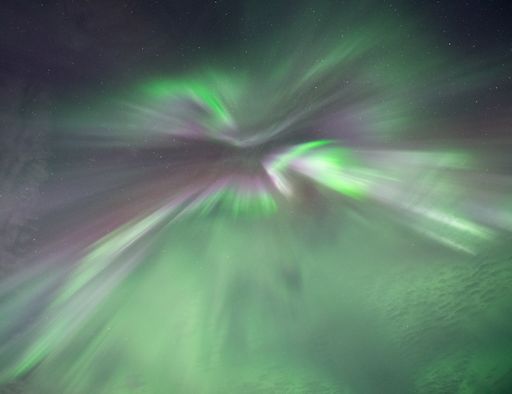
"We were on the lookout for the CME," says Robba. "We got some lovely coronas directly overhead, and lots of activity all over the sky. It didn't hold for long but it was just beautiful!"
NOAA forecasters say the storm could intensify to G2-class on Sept. 13th when a solar wind stream unrelated to the CME arrives. If so, auroras in the USA could appear as low as New York to Wisconsin to Washington state. Free: Aurora Alerts
Realtime Space Weather Photo Gallery
SOLAR RADIATION STORM AND GROUND LEVEL EVENT: On Sept. 10th, departing sunspot AR2673 erupted, producing a powerful X8-class solar flare. The explosion propelled a CME into space and accelerated a swarm of energetic protons toward Earth. Both are visible in this coronagraph movie from the Solar and Heliospheric Observatory (SOHO):
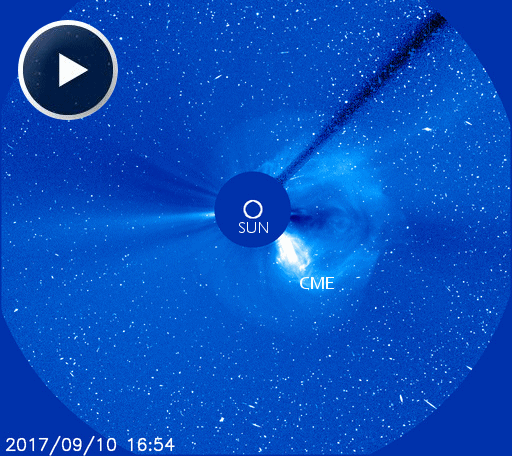
The many specks in this movie are not stars--they are solar protons striking SOHO's digital camera. Almost two days later these protons are still streaming past our planet, causing a moderately strong (S2-class) solar radiation storm. The latest data from SOHO show an ongoing blizzard of digital "snow" in coronagraph images:

What made this flare so 'radioactive'? It has to do with the location of AR2673 at the time of the explosion. The sun's western limb is magnetically well-connected to Earth. Look at this diagram. Magnetic fields spiraling back from the blast site led directly to our planet, funneling these energetic protons Earthward.
Normally, solar radiation storms are held at bay by our planet's magnetic field and upper atmosphere. On Sept.10th, however, there was a "ground level event" (GLE). Neutron monitors in the Arctic, Antarctic, and several other high latitude locations detected a surge of particles reaching all the way down to Earth's surface:
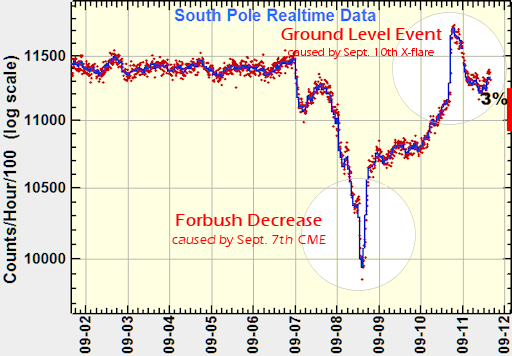 :
:
The Bartol Research Institute's South Pole Neutron Monitor detected a GLE on Sept. 10th.
""In historical terms, this was a relatively small ground level event-- only about one thousandth as strong as the event of 23 Feb 1956, which is the largest measured," says Clive Dyer, a Visiting Professor at the University of Surrey Space Centre.
However, that does not mean the Sept.10th GLE was negligible. Dyer says that "passengers flying on high-latitude routes at 40,000 feet could have absorbed an extra 10 microSieverts of radiation. During the first hour of the GLE, the dose rate inside the aircraft during such a flight would have approximately doubled."
He also notes that the GLE could have caused minor upsets of onboard electronics and avionics, although nothing on the scale of the epic 1956 GLE, "which would be very challenging to modern systems."
"Since measurements began around 1942 there have now been 73 events detected by ground level radiation monitors," Dyer adds. "The Sept.10, 2017, event is far from the strongest, but it is of special interest because it demonstrates the need for continual vigilance even during Solar Minimum."
Realtime Space Weather Photo Gallery
ROSE QUARTZ CRYSTAL ECLIPSE PENDANTS: On Aug. 21st during the Great American Solar Eclipse, the students of Earth to Sky Calculus launched 11 space weather balloons from the path of totality. They aimed to photograph the Moon's shadow from the stratosphere--and they succeeded. As a fundraiser, some of the balloons carried jewelry. Here is a rose quartz crystal pendant entering the Moon's shadow more than 90,000 feet above the Malheur National Forest in eastern Oregon:

During the 2.5 hour flight, the pendants were wrapped in the Moon's shadow for more than two minutes, experiencing a spooky darkness colder than -50 C.
You can have one for $149.95. Each crystal pendant comes with a unique gift card showing the jewelry passing through the Moon's shadow and floating at the top of Earth's atmosphere. The interior of the card tells the story of the flight and confirms that this gift has been to the edge of space and back again.
Far Out Gifts: Earth to Sky Store
All proceeds support hands-on STEM education
Realtime Aurora Photo Gallery
Solar Eclipse Photo Gallery
Every night, a network of
NASA all-sky cameras scans the skies above the United States for meteoritic fireballs. Automated software maintained by NASA's Meteoroid Environment Office calculates their orbits, velocity, penetration depth in Earth's atmosphere and many other characteristics. Daily results are presented here on Spaceweather.com.
On Sep. 13, 2017, the network reported 6 fireballs.
(6 sporadics)

In this diagram of the inner solar system, all of the fireball orbits intersect at a single point--Earth. The orbits are color-coded by velocity, from slow (red) to fast (blue). [Larger image] [movies]
Potentially Hazardous Asteroids (
PHAs) are space rocks larger than approximately 100m that can come closer to Earth than 0.05 AU. None of the known PHAs is on a collision course with our planet, although astronomers are finding
new ones all the time.
On September 13, 2017 there were 1803 potentially hazardous asteroids.
 |
Recent & Upcoming Earth-asteroid encounters: | Asteroid | Date(UT) | Miss Distance | Velocity (km/s) | Diameter (m) |
| 2017 OP68 | 2017-Sep-10 | 20 LD | 11.7 | 246 |
| 2017 QK18 | 2017-Sep-11 | 14.8 LD | 7.8 | 45 |
| 2014 RC | 2017-Sep-11 | 15.1 LD | 8.9 | 16 |
| 2017 PR25 | 2017-Sep-23 | 17.9 LD | 13.5 | 236 |
| 1989 VB | 2017-Sep-29 | 7.9 LD | 6.3 | 408 |
| 2017 OD69 | 2017-Oct-01 | 13.2 LD | 7.6 | 213 |
| 2012 TC4 | 2017-Oct-12 | 0.1 LD | 7.6 | 16 |
| 2005 TE49 | 2017-Oct-13 | 8.5 LD | 11.2 | 16 |
| 2013 UM9 | 2017-Oct-15 | 17 LD | 7.8 | 39 |
| 2006 TU7 | 2017-Oct-18 | 18.7 LD | 13.3 | 148 |
| 171576 | 2017-Oct-22 | 5.8 LD | 21.2 | 677 |
| 2003 UV11 | 2017-Oct-31 | 15 LD | 24.5 | 447 |
Notes: LD means "Lunar Distance." 1 LD = 384,401 km, the distance between Earth and the Moon. 1 LD also equals 0.00256 AU. MAG is the visual magnitude of the asteroid on the date of closest approach. | | Cosmic Rays in the Atmosphere |
Readers, thank you for your patience while we continue to develop this new section of Spaceweather.com. We've been working to streamline our data reduction, allowing us to post results from balloon flights much more rapidly, and we have developed a new data product, shown here:
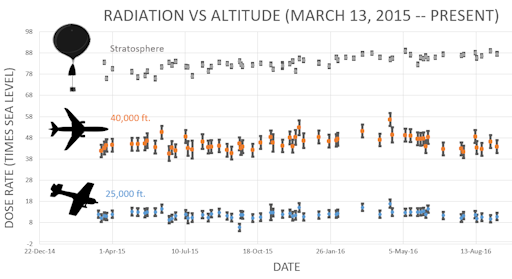
This plot displays radiation measurements not only in the stratosphere, but also at aviation altitudes. Dose rates are expessed as multiples of sea level. For instance, we see that boarding a plane that flies at 25,000 feet exposes passengers to dose rates ~10x higher than sea level. At 40,000 feet, the multiplier is closer to 50x. These measurements are made by our usual cosmic ray payload as it passes through aviation altitudes en route to the stratosphere over California.
What is this all about? Approximately once a week, Spaceweather.com and the students of Earth to Sky Calculus fly space weather balloons to the stratosphere over California. These balloons are equipped with radiation sensors that detect cosmic rays, a surprisingly "down to Earth" form of space weather. Cosmic rays can seed clouds, trigger lightning, and penetrate commercial airplanes. Furthermore, there are studies ( #1, #2, #3, #4) linking cosmic rays with cardiac arrhythmias and sudden cardiac death in the general population. Our latest measurements show that cosmic rays are intensifying, with an increase of more than 13% since 2015:
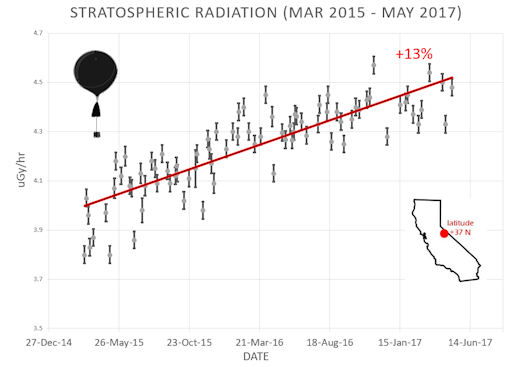
Why are cosmic rays intensifying? The main reason is the sun. Solar storm clouds such as coronal mass ejections (CMEs) sweep aside cosmic rays when they pass by Earth. During Solar Maximum, CMEs are abundant and cosmic rays are held at bay. Now, however, the solar cycle is swinging toward Solar Minimum, allowing cosmic rays to return. Another reason could be the weakening of Earth's magnetic field, which helps protect us from deep-space radiation.
The radiation sensors onboard our helium balloons detect X-rays and gamma-rays in the energy range 10 keV to 20 MeV. These energies span the range of medical X-ray machines and airport security scanners.
The data points in the graph above correspond to the peak of the Reneger-Pfotzer maximum, which lies about 67,000 feet above central California. When cosmic rays crash into Earth's atmosphere, they produce a spray of secondary particles that is most intense at the entrance to the stratosphere. Physicists Eric Reneger and Georg Pfotzer discovered the maximum using balloons in the 1930s and it is what we are measuring today.
| | The official U.S. government space weather bureau |
| | The first place to look for information about sundogs, pillars, rainbows and related phenomena. |
| | Researchers call it a "Hubble for the sun." SDO is the most advanced solar observatory ever. |
| | 3D views of the sun from NASA's Solar and Terrestrial Relations Observatory |
| | Realtime and archival images of the Sun from SOHO. |
| | from the NOAA Space Environment Center |
| | a proud supporter of science education and Spaceweather.com |
| | fun to read, but should be taken with a grain of salt! Forecasts looking ahead more than a few days are often wrong. |
| | from the NOAA Space Environment Center |
| | the underlying science of space weather |
 | Reviews here can help you to pick up best memory foam mattresses. |
| | These links help Spaceweather.com stay online. Thank you to our supporters! |
| | | | | | |

